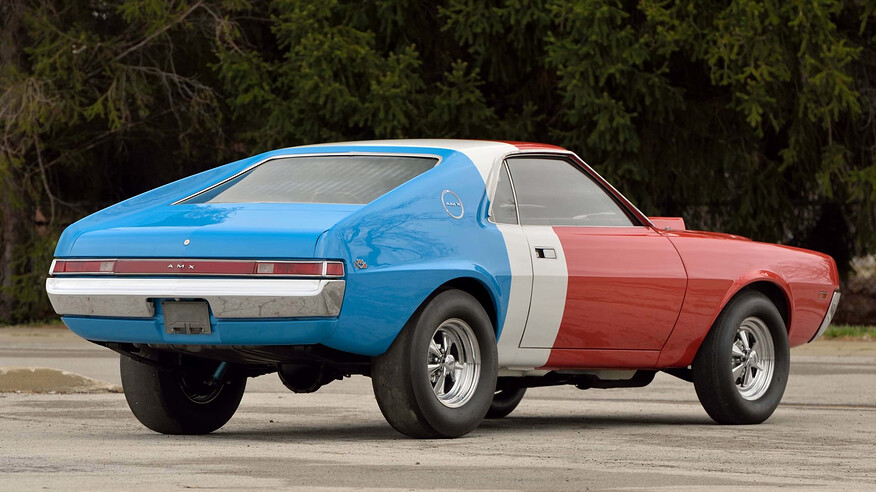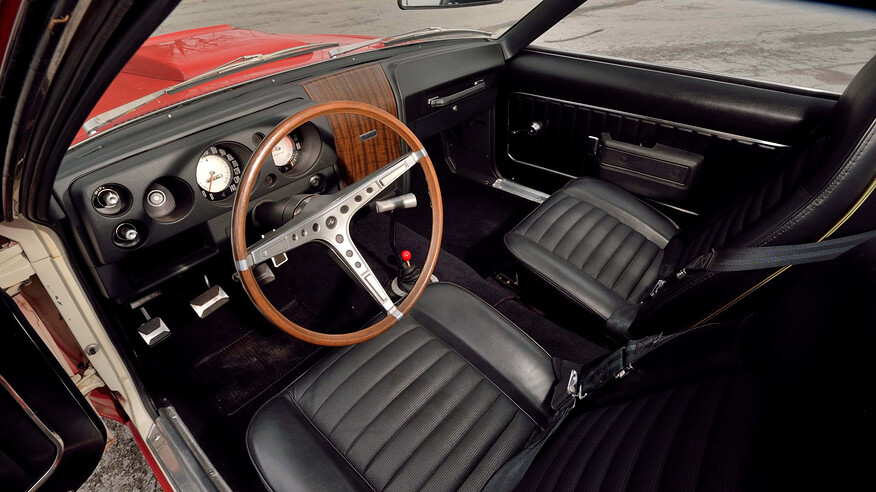1968 AMC AMX
Country of Origin: USA
Design Info: The first two-seat, steel-bodied sports car in America since the original Ford Thunderbird, the AMX was designed to appeal to a younger, sportier market than virtually everything else on offer from the company. Over its three-year run, the car would incorporate several industry-first engineering techniques, including a single-piece injection molded dash and lightweight windshields developed by Corning which would crumble under impact, instead of delivering force to the striking object (like the occupant’s head).
Engine Info: The 1968 AMX was available with 3 different sizes of the AMC Gen 2 ‘Short-Deck” V8, 290, 343, and 390 cubic inch engines. The 390 was developed alongside the AMX and was the most powerful engine AMC had yet produced, with 315 hp and 425 lb-ft of toque. Notably, all three V8s shared the same external dimensions, roughly similar in size to GM’s small-block V8s. All AMXs were equipped with four-barrel carburetors and dual exhaust.
Type: An unusual car, in that it was a two-seater derived from a larger four seat muscle car design, the AMX is something of a hybrid between muscle and sports car. It was aimed squarely at the Corvette, which it was considerably cheaper than (but also not quite as fast). It was also frequently compared to European sports cars of its time, however, having similar handling and significantly greater acceleration than most.
History: By the mid ‘60s, Roy Abernethy knew that AMC had an image problem. His predecessor, George Romney, spent the better part of the 50s as the President of the fourth-largest automotive company in America fighting tooth and nail against the Big Three, predominantly by marketing AMCs as small economy cars against the “gas-guzzling dinosaurs” produced by their rivals, as well as competing with foreign imports from Japan and Germany.
The problem was that there was no car in AMC’s lineup that appealed to the youth market. Indeed, throughout Romney’s tenure (and into Abernethy’s own) there had been a corporate aversion to racing and performance-oriented models, owing largely to a ban on factory supported motorsport issued by the AMA (Automobile Manufacturers Association) in response to high-profile accidents at Le Mans in 1955 and Martinsville Raceway in 1957. In 1962, however, Henry Ford II announced that Ford would once again be sponsoring auto racing in NASCAR, and Abernethy’s desire to compete with the Big Three meant that AMC, too, would need to enter the realm of performance vehicles.
Dick Teague, who would later famously design the Gremlin, Pacer, and XJ Cherokee, was tasked with designing a sporty fastback concept car which would become known as the Rambler Tarpon. The Tarpon was altered, enlarged, and brought to market as the Rambler (later AMC) Marlin. The Marlin had some success, but its large size detracted from its sportiness, and it did not fulfill AMC’s need. Luckily, Abernethy did not give up, and instead greenlit Project IV, the design of four full-size model concepts for autoshows in 1966. Two of these concepts, American Motors Experimental I & II would be the basis for two eventual production cars: The Javelin, and the AMX.
The two-seat AMX I concept was a fiberglass, non-functional “pusher” meant only to show the new design to the public. It was so popular, however, that Abernethy commissioned coachbuilder Vignale (designer of many significant Ferraris, Maseratis, and others) to build a working show car out of steel. The four seat AMX II concept was more practical and less radical in design, however, and would serve as the basis for AMC’s Javelin. The company wasn’t done with the AMX, however.
Production of the Javelin began in 1967 for the 1968 model year, but AMC’s engineers also prepared a production design for the two-seat AMX. Using the very same clay model which had been made for the Javelin, designers resculpted and remade the Javelin into a two-seat sports coupe, fulfilling Abernethy’s desire for a cheap competitor for GM’s Chevrolet Corvette. Unfortunately for Abernethy, by this point he had been forced to take an “early retirement” as AMC had lost its profitability under his leadership. While there was some evidence that his business strategies had been working, he was unable to adapt the company fast enough to the changing market.
The AMX itself was released in 1968 as a mid-year model, and was quite successful as a halo car, bringing significant numbers of young people into dealerships. Many automotive journalists remarked upon to good looks and performance of the car, and internally AMC Vice President Vic Raviolo referred to the car as “Walter Mitty’s Ferrari”. AMC even hired world speed record holder Craig Breedlove, driver of the Spirit of America, to set speed endurance records in the new car. At the Goodyear Proving Grounds in Texas, Breedlove’s team managed an average of over 140 miles per hour for 12 hours, including a portion of time driving at speeds exceeding 155 mph in the dark with no headlights to conserve battery power. The AMX set 106 different records before one had ever been sold.
Unfortunately, selling was something the AMX wasn’t great at. While the car had generated a great deal of excitement, its unusual status as a hybrid muscle/sports car bred market confusion, and AMC only sold about 19,000 AMXs over three years (in comparison to well over 100,000 Javelins over roughly the same time). For 1971, the two-seat AMX was discontinued, and the name lived on only as a trim level for the Javelin (and later the Hornet, Concord, and Spirit).
Why it’s cool/unique/significant:
In addition to the AMX’s historical importance to AMC, and its record-setting drives at the hands of Breedlove and his team, the AMX was also a significant presence in American racing. Though the car was ineligible for the SCCA’s Trans-Am competition, it performed well in other SCCA events including a 2nd place in the 1969 National Championship, held at Daytona. The AMX was successful at dragstrips across the country, including Super Stock cars built expressly for the purpose. Shirley Shahan (nicknamed “Drag-On Lady”), the first woman to win an NHRA Pro event, began driving for AMC with an AMX in 1968 with moderate success. AMX’s were used as pace and practice cars in the 1969 Pikes Peak Hill Climb, and a ‘69 was used by two brothers in the 1971 and 1972 Cannonball Baker Sea-to-Shining-Sea Memorial Trophy Dash (Better known as the Cannonball Run), finishing in 5th and 8th place respectively. Their first run completed the 2897 miles from New York to Los Angeles in 37 hours and 48 minutes at an average speed of 77.3 mph.
Of course, the real reason that the AMC AMX is unique is because of its context. It was a performance car from a company that didn’t do performance cars, a sports car in a country that didn’t really build sports cars. It arguably deserved more credit than it ever got, and helped AMC’s image at a time when it needed it.














